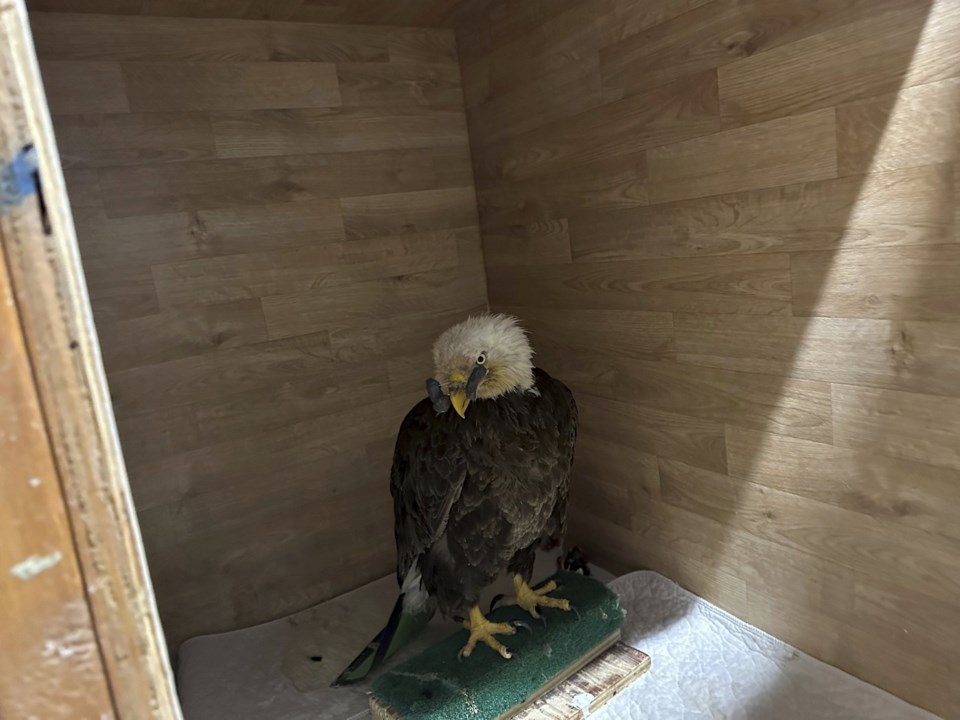VALLEY PARK, Mo. (AP) ŌĆö A bald eagle is slowly recovering after surgeries in Missouri, the victim of a shooting that experts say is far too common for America's national bird and other raptors.
The male eagle was found injured in central Missouri on July 11. A volunteer with the World Bird Sanctuary picked it up and brought the 7-pound (3.2-kilogram) adult back to the sanctuary in suburban St. Louis.
Roger Holloway, the sanctuary's executive director, said the eagle's upper beak was nearly split in half by the bullet. It also had an injured left wing and suffered from lead poisoning.
The eagle, designated No. 24-390 because it is the 390th injured bird treated at the sanctuary this year, has undergone three surgeries. Holloway said an operation last week was to further repair the severely damaged beak ŌĆö a serious injury that would be life-ending if it doesn't heal.
The good news: Suture sites from earlier surgeries are healing well, and so are jaw fractures caused by the force of the bullet, Holloway said. Another procedure is likely in early September.
But even if all goes well, No. 24-390 will require months of care, perhaps even a year, before he could conceivably be released back into the wild.
ŌĆ£WeŌĆÖre just being cautiously optimistic that heŌĆÖs otherwise healthy and has gained weight, is processing food well, and heŌĆÖs getting feistier and less cooperative, which we really like,ŌĆØ Holloway said. ŌĆ£Because the bird is wild and it's got strength, and thatŌĆÖs what it needs to have the ability grow the beak back to its functional size and length.ŌĆØ
No. 24-390 is among six raptors treated for gunshot wounds this summer at the World Bird Sanctuary. About 600 birds are treated there each year, most of them hurt in various types of collisions.
Holloway and other experts say they're seeing an increase in shooting injuries to the majestic birds, which have served as the national symbol of the United States for nearly two-and-a-half centuries. Both bald and golden eagles also are widely considered sacred by Native Americans.
U.S. law prohibits anyone without a permit from killing, wounding or disturbing eagles, or taking their nests or eggs. Even taking can be a crime.
In the late 1800s, America was home to around 100,000 nesting bald eagles. Habitat destruction and hunting nearly made the birds extinct, prompting Congress to pass the Bald Eagle Protection Act in 1940 that made it illegal to possess, kill or sell bald eagles.
Pesticides continued to kill bald eagles, and by 1960 only about 400 breeding pairs remained. The bald eagle was put on the endangered species list in 1978.
Federal protections and regulation of pesticides containing DDT prompted a comeback. In 1995 the bald eagle's status was changed from endangered to threatened, and it was removed from the threatened list in 2007.
Eighteen years ago, Missouri had 123 confirmed bald eagle nests, said Janet Haslerig, avian ecologist for the Missouri Department of Conservation. Today, there are 609.
But as the population has grown nationwide, so have the number of shootings.
ŌĆ£ItŌĆÖs trending up and very disturbing,ŌĆØ Haslerig said.
In March, a Washington state man accused of helping pleaded guilty in federal court to shooting eagles on a Native American reservation in Montana and and body parts on the black market.
Many other shootings are due to a combination of ŌĆ£ignorance and boredom,ŌĆØ Holloway said.
ŌĆ£Sometimes, itŌĆÖs just like, ŌĆśI have a gun. ThereŌĆÖs a target,ŌĆÖŌĆØ he said. "They donŌĆÖt understand the laws and rules. They donŌĆÖt understand theyŌĆÖre committing a felony.
ŌĆ£This is just indiscriminate shooting from irresponsible individuals.ŌĆØ
Jim Salter, The Associated Press




